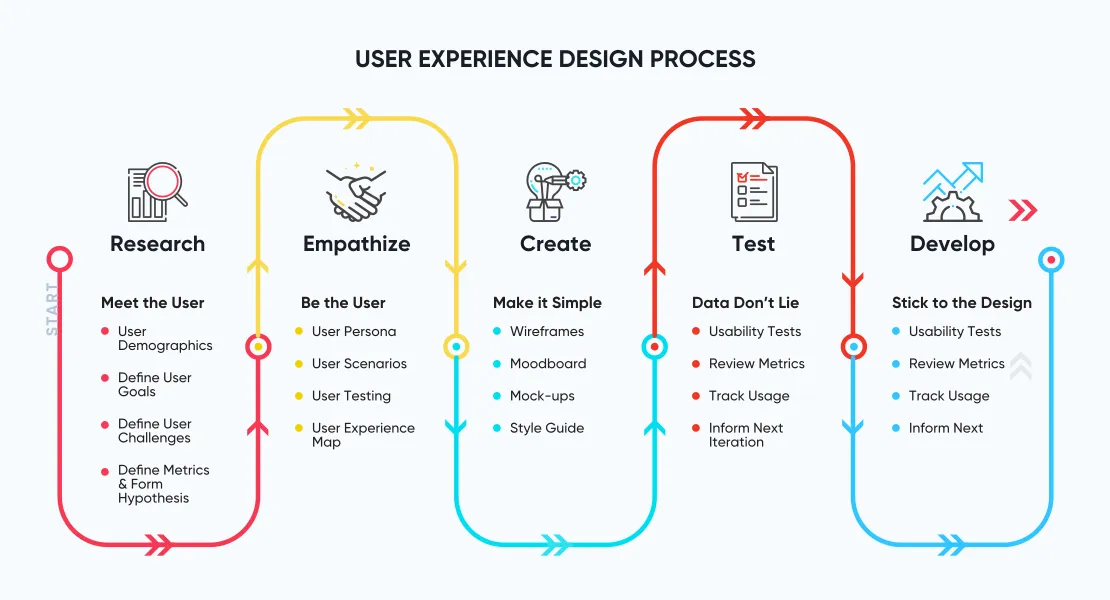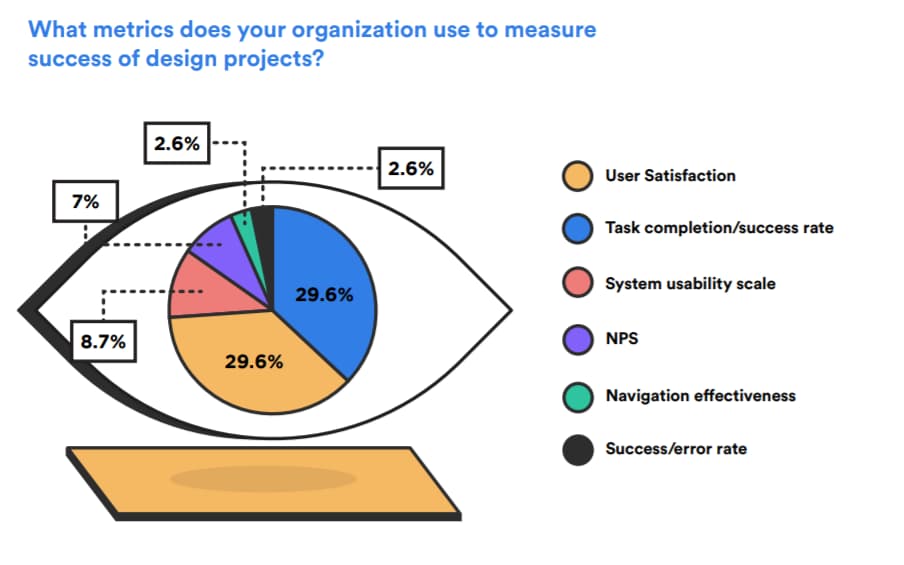Top 5 Metrics To Measure The Success Of Your Ux Design
6 Mins Read
Published on: 22 February 2023
Last Updated on: 09 October 2024

toc impalement
As the world is becoming more digital, UX design has become essential in creating a user-friendly and engaging experience. As such, hiring a UX designer is essential to ensure that your website or app is easy to navigate, visually appealing, and meets the user’s needs.
This article will examine the most critical UX KPIs (key performance indicators) and how to measure them.
But first, let’s understand why measuring UX design metrics is essential:
Why Track UX Metrics And Kpis?

Source: Net Solutions
Tracking User Experience (UX) metrics and Key Performance Indicators (KPIs) is essential to measure the success of a website or application.
UX designers can help companies achieve better user experiences by analyzing user behavior and feedback. Having the google ux design is much easier, and you can track the performances of the UX Metrics and KPIs.
Here are some reasons why tracking UX metrics and KPIs is crucial for businesses:
To Identify User Needs: UX metrics and KPIs can help identify user needs, improving user engagement and increasing conversions. A UX designer can help businesses develop user personas and scenarios to identify user needs and provide solutions.
To Improve User Experience: UX designers can use metrics and KPIs to improve the user experience by optimizing the user interface, reducing load time, and improving the user journey.
To Increase ROI: Tracking UX metrics and KPIs can help businesses increase their return on investment (ROI) by identifying areas that require improvement, such as bounce rates, abandoned carts, or low engagement rates.
To Measure Success: UX metrics and KPIs can be used to measure a website’s or application’s success, which can notify future decisions and investments.
You can hire a UX designer to track UX metrics and KPIs if you want to improve your website or application. They can help you identify user needs, optimize the user interface, and enhance the user experience, leading to increased conversions and ROI.
Now you understand why measuring UX metrics, it’s time to explore how you can measure the metrics through different practices.
5 Key Metrics To Measure Ux Designs
The success of your UX design can only be measured by how well it meets the needs and expectations of your users. To do this, you need to use the right UX metrics to evaluate the effectiveness of your design.
Further, we’ll discuss the key UX metrics you should use to measure the success of your UX design and improve user satisfaction.
1. Task Completion Rate (TCR)
The Task Completion Rate (TCR) measures the percentage of users who complete a specific task or action on your website or app. This metric can be used to assess the usability of your interface and determine if users can navigate through the product quickly.
To calculate TCR, divide the number of users who complete the task by the total number of users who attempted it. A high TCR indicates that your UX design is effective and that users can complete tasks quickly and efficiently.
2. User Engagement

Source: DePalma Studio
User engagement measures how actively your users interact with your website or app. It includes metrics like the number of sessions, duration, and pages visited. A high level of user engagement indicates that your product is engaging and provides value to users.
One way to measure user engagement is by using Google Analytics. You can track the number of sessions, average session duration, and pages per session to understand how engaged your users are. Additionally, you can use heat maps and user behavior analytics to identify areas of your product that are popular and areas that require improvement.
3. Net Promoter Score (NPS)
The Net Promoter Score (NPS) is a popular measure of customer satisfaction and loyalty. It asks users a single question, “On a scale of 0-10, how likely are you to recommend our product to a friend or colleague?” Users who rate your product 9 to 10 are considered “promoters,” while those who rate it 0-6 are considered “detractors.”
To calculate your NPS, start by subtracting the percentage through the detractors from the percentages of promoters. A high NPS indicates that your product has increased customer satisfaction and loyalty.
4. Conversion Rate
This metric measures the percentage of users who complete a specific goal on your website or app. It can be a purchase, a sign-up, or any other action contributing to your business objectives. A high conversion rate indicates that your UX design is effective and that users are more likely to take the desired action.
To calculate your conversion rate, first, divide the number of users who completed the goal by the total number of users who visited your site or app. You can use A/B testing and user feedback to optimize your UX design and improve your conversion rate.
5. Time On Task
Time on Task measures users’ time to complete a specific task or action on your website or app. This metric can identify areas where users may be struggling or experiencing frustration. You can improve user satisfaction and engagement by reducing the time it takes to complete a task.
To measure Time on Tasks, use tools like Hotjar or UserTesting to track how long it takes users to complete specific tasks on your site or app. Identify areas where users may be spending too much time and consider redesigning those elements to make them more intuitive.
How Do You Choose The Right UX Metric?
Choosing the right UX metric is crucial to the success of any digital product or service. It allows businesses to measure and improve user experience and increase customer satisfaction. The demand for exceptional UX design is rising in today’s competitive market.
This is why many businesses are looking to hire UX designers to help them select and measure the right UX metrics. Here are some tips on how to choose the right UX metric:
Understand Your Goals
Before selecting any UX metric, you need to understand your goals. What are you trying to achieve? What is your target audience? What do you want your customers to do? Understanding these questions will help you choose the right UX design metric that aligns with your business objectives.
For example, you should track the engagement metric, such as time spent on your website or app, to increase customer retention.
Choose Quantitative Metrics
Quantitative metrics allow you to measure the effectiveness of your UX design. These objective and data-driven metrics provide you with accurate and reliable information.
Some examples of quantitative metrics include conversion rates, bounce rates, click-through rates, and time on page. These metrics can be measured using analytics tools and provide clear and actionable insights.
Source: Eagle
Qualitative Metrics
Qualitative metrics are subjective and focus on the user’s experience. These metrics allow you to gather feedback and insights on how users interact with your product. Qualitative metrics can be gathered through surveys, user testing, and focus groups.
Some examples of qualitative metrics include user satisfaction, usability, and ease of use.
Consider The Context
The context in which your users interact with your product is crucial when choosing the right UX metric. For example, when designing a mobile app, focus on metrics relevant to the mobile experience, such as load times, touch targets, and screen sizes.
Similarly, if you are designing an e-commerce website, focus on metrics such as cart abandonment rates and checkout completion rates.
In conclusion, choosing the right UX metric is essential for improving user experience and increasing customer satisfaction. Hiring a UX designer can help you select and measure the right metrics that align with your business goals.
Wrapping Up
By measuring the right UX metrics, you can assess the effectiveness of your UX design and make data-driven decisions to improve user satisfaction and engagement. You can use the metrics mentioned above to identify areas of your product that work well and require improvement. If you need help measuring your UX design’s success, consider hiring a UX designer to help you optimize your product and create seamless UX design products.
Read Also:


















Comments Are Closed For This Article